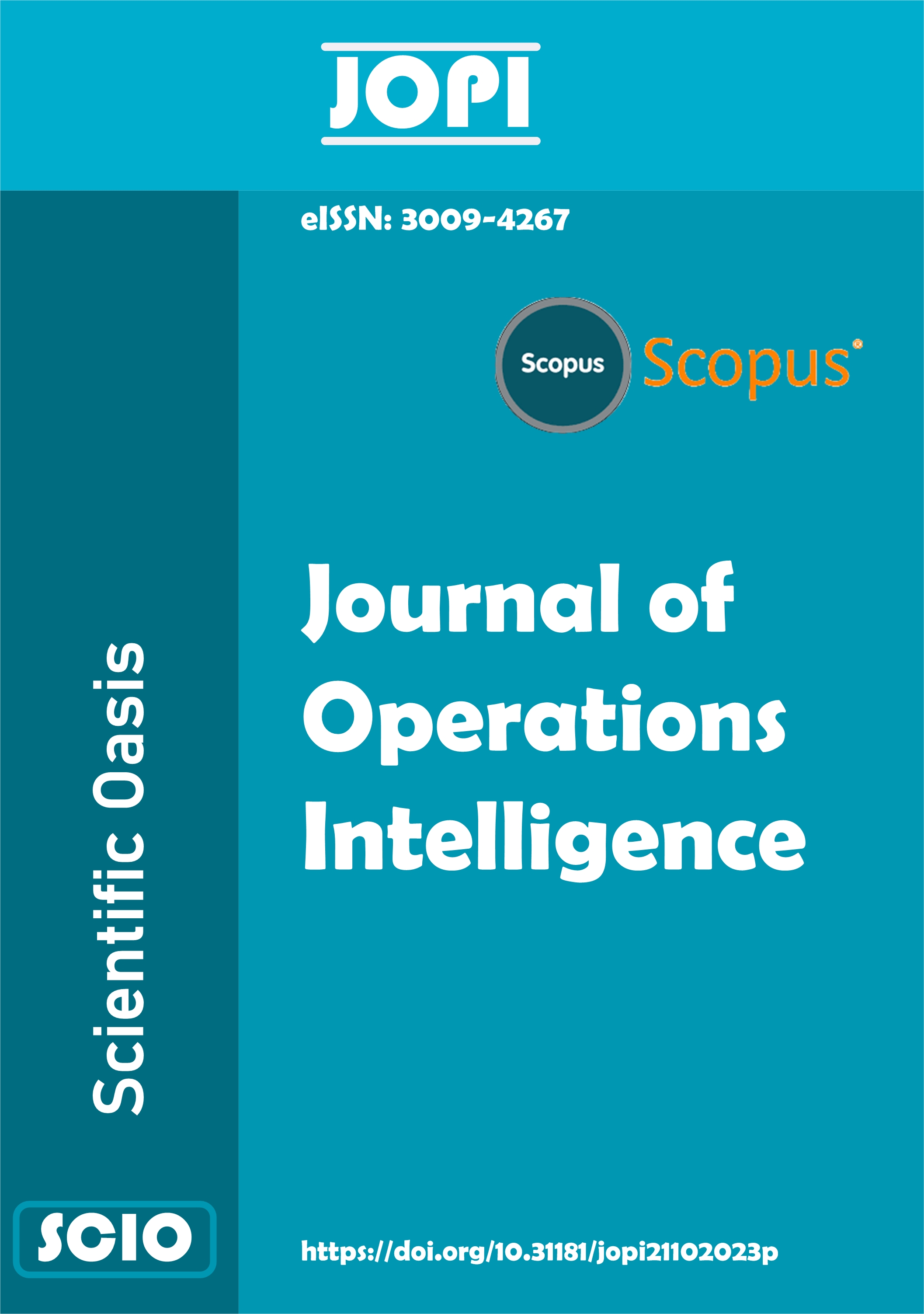Predictive Stock Selection: A Hybrid RF-CNN XGBoost Model Integrated with Dynamic Adaptive Index and Stepwise Elimination Techniques
DOI:
https://doi.org/10.31181/jopi31202545Keywords:
Stock Selection, Stock prediction, Random Forest, XGBoost, Dynamic Adaptive IndexAbstract
This paper presents a predictive model for stock selection using a hybrid approach. The proposed model, which combines advanced machine learning algorithms with a dynamic adaptive index (DAI), aims to enhance portfolio performance and risk management. In this context, Random Forest (RF) and XGBoost algorithms are utilized to select optimal features and forecast stock returns. In the subsequent step, the DAI method assesses and selects stocks. By integrating various metrics such as correlation, volatility, relative strength index (RSI), and cumulative returns, the DAI method enables a comprehensive assessment of available stocks that dynamically adapts to changing market conditions. In addition, the stepwise elimination technique optimizes the portfolio by eliminating stocks with high volatility and low returns, ensuring that only stocks with strong performance and acceptable risk are retained. The two-stage structure of the proposed model, encompassing stock return prediction and stock selection, enhances the model's overall efficiency. The presented hybrid model excels in stock selection and risk management, helping investors achieve higher returns while reducing portfolio risk.
Downloads
References
Rather, A. M., Sastry, V. N., & Agarwal, A. (2017). Stock market prediction and Portfolio selection models: A survey. OPSEARCH, 54(3), 558–579. https://doi.org/10.1007/s12597-016-0289-y
Yang, F., Chen, Z., Li, J., & Tang, L. (2019). A novel hybrid stock selection method with stock prediction. Applied Soft Computing, 80, 820–831. https://doi.org/10.1016/j.asoc.2019.03.028
Yuan, X., Yuan, J., Jiang, T., & Ain, Q. U. (2020). Integrated Long-Term Stock Selection Models Based on Feature Selection and Machine Learning Algorithms for China Stock Market. IEEE Access, 8, 22672–22685. https://doi.org/10.1109/ACCESS.2020.2969293
Sezer, O. B., Ozbayoglu, M., & Dogdu, E. (2017). A Deep Neural-Network Based Stock Trading System Based on Evolutionary Optimized Technical Analysis Parameters. Procedia Computer Science, 114, 473–480. https://doi.org/10.1016/j.procs.2017.09.031
Sezer, O. B., Gudelek, M. U., & Ozbayoglu, A. M. (2020). Financial time series forecasting with deep learning: A systematic literature review: 2005–2019. Applied Soft Computing, 90, 106181. https://doi.org/10.1016/j.asoc.2020.106181
Paiva, F. D., Cardoso, R. T. N., Hanaoka, G. P., & Duarte, W. M. (2019). Decision-making for financial trading: A fusion approach of machine learning and portfolio selection. Expert Systems with Applications, 115, 635–655. https://doi.org/10.1016/j.eswa.2018.08.003
Ma, B., Xue, Y., Lu, Y., & Chen, J. (2025). Stockformer: A price–volume factor stock selection model based on wavelet transform and multi-task self-attention networks. Expert Systems with Applications, 273, 126803. https://doi.org/10.1016/j.eswa.2025.126803
Alzaman, C. (2025). Optimizing portfolio selection through stock ranking and matching: A reinforcement learning approach. Expert Systems with Applications, 269, 126430. https://doi.org/10.1016/j.eswa.2025.126430
Sarkar, P., Khanapuri, V. B., & Tiwari, M. K. (2025). Integration of prediction and optimization for smart stock portfolio selection. European Journal of Operational Research, 321(1), 243–256. https://doi.org/10.1016/j.ejor.2024.08.027
Gao, Q., Zhou, X., Huang, L., Zhang, K., Liu, S., & Zhou, F. (2024). Relational Fusion-based Stock Selection with Neural Recursive Ordinary Differential Equation Networks. Information Fusion, 110, 102468. https://doi.org/10.1016/j.inffus.2024.102468
Lv, M., Wang, J., Wang, S., Gao, J., & Guo, H. (2024). Developing a hybrid system for stock selection and portfolio optimization with many-objective optimization based on deep learning and improved NSGA-III. Information Sciences, 670, 120549. https://doi.org/10.1016/j.ins.2024.120549
Vasantha Lakshmi, K., & Udaya Kumara, K. N. (2023). A novel randomized weighted fuzzy AHP by using modified normalization with the TOPSIS for optimal stock portfolio selection model integrated with an effective sensitive analysis. Expert Systems with Applications, 243, 122770. https://doi.org/10.1016/j.eswa.2023.122770
Alzaman, C. (2024). Deep learning in stock portfolio selection and predictions. Expert Systems with Applications, 237, 121404. https://doi.org/10.1016/j.eswa.2023.121404
Brito, I. (2023). A portfolio stock selection model based on expected utility, entropy and variance. Expert Systems with Applications, 213, 118896. https://doi.org/10.1016/j.eswa.2022.118896
Silva, N. F., de Andrade, L. P., da Silva, W. S., de Melo, M. K., & Tonelli, A. O. (2024). Portfolio optimization based on the pre-selection of stocks by the Support Vector Machine model. Finance Research Letters, 61, 105014. https://doi.org/10.1016/j.frl.2024.105014
Mitra Thakur, G. S., Bhattacharyya, R., & Sarkar (Mondal), S. (2018). Stock portfolio selection using Dempster–Shafer evidence theory. *Journal of King Saud University - Computer and Information Sciences, 30*(2), 223–235. https://doi.org/10.1016/j.jksuci.2016.07.001
Putra, Y. E., Saepudin, D., & Aditsania, A. (2021). Portfolio Selection of KOMPAS-100 Stocks Index Using B-Spline Based Clustering. Procedia Computer Science, 179, 375–382. https://doi.org/10.1016/j.procs.2021.01.019
Chen, B., Zhong, J., & Chen, Y. (2020). A hybrid approach for portfolio selection with higher-order moments: Empirical evidence from Shanghai Stock Exchange. Expert Systems with Applications, 145, 113104. https://doi.org/10.1016/j.eswa.2019.113104
Yan, Y., Zhang, C., Li, X., & Zhang, B. (2024). A framework for stock selection via concept-oriented attention representation in hypergraph neural network. *Knowledge-Based Systems, 284*, 111326. https://doi.org/10.1016/j.knosys.2023.111326
Caparrini, A., Arroyo, J., & Escayola Mansilla, J. (2024). S&P 500 stock selection using machine learning classifiers: A look into the changing role of factors. Research in International Business and Finance, 70, 102336. https://doi.org/10.1016/j.ribaf.2024.102336
Asawa, Y. S. (2022). Modern Machine Learning Solutions for Portfolio Selection. IEEE Engineering Management Review, 50(1), 94–111. https://doi.org/10.1109/EMR.2021.3131158
Padhi, D. K., Padhy, N., Bhoi, A. K., Shafi, J., & Yesuf, S. H. (2022). An Intelligent Fusion Model with Portfolio Selection and Machine Learning for Stock Market Prediction. Computational Intelligence and Neuroscience, 2022, 1–18. https://doi.org/10.1155/2022/7588303
Rasekhschaffe, K. C., & Jones, R. C. (2019). Machine Learning for Stock Selection. Financial Analysts Journal, 75(3), 70–88. https://doi.org/10.1080/0015198X.2019.1596678
Zhao, T., Ma, X., Li, X., & Zhang, C. (2023). Asset correlation based deep reinforcement learning for the portfolio selection. Expert Systems with Applications, 221, 119707. https://doi.org/10.1016/j.eswa.2023.119707
Abolmakarem, S., Abdi, F., Khalili-Damghani, K., & Didehkhani, H. (2024). A multi-stage machine learning approach for stock price prediction: Engineered and derivative indices. Intelligent Systems with Applications, 24, 200449. https://doi.org/10.1016/j.iswa.2024.200449
Downloads
Published
Issue
Section
License
Copyright (c) 2025 Farshid Abdi, Shaghayegh Abolmakarem, Amir Karbassi Yazdi (Author)

This work is licensed under a Creative Commons Attribution 4.0 International License.





















